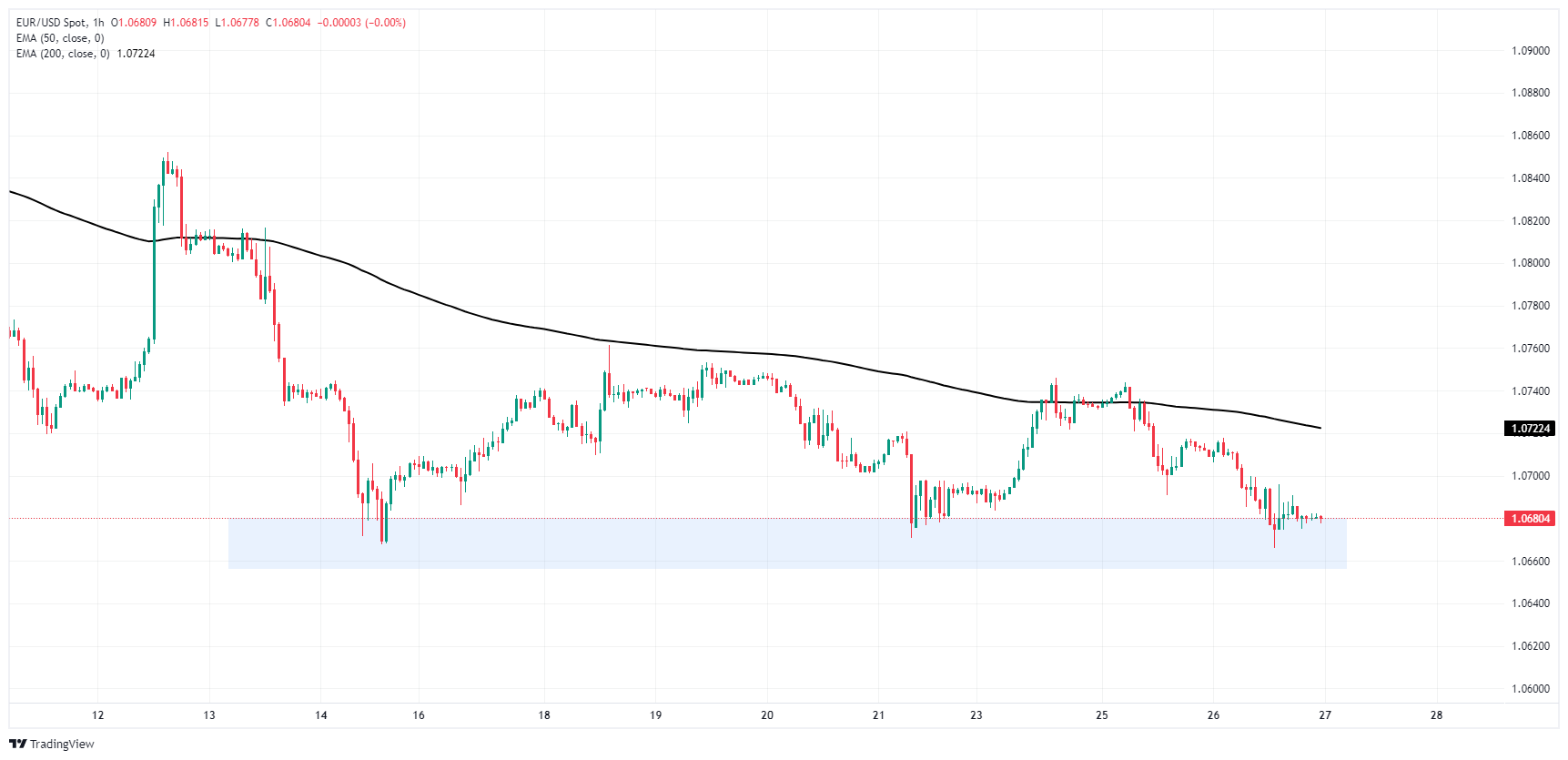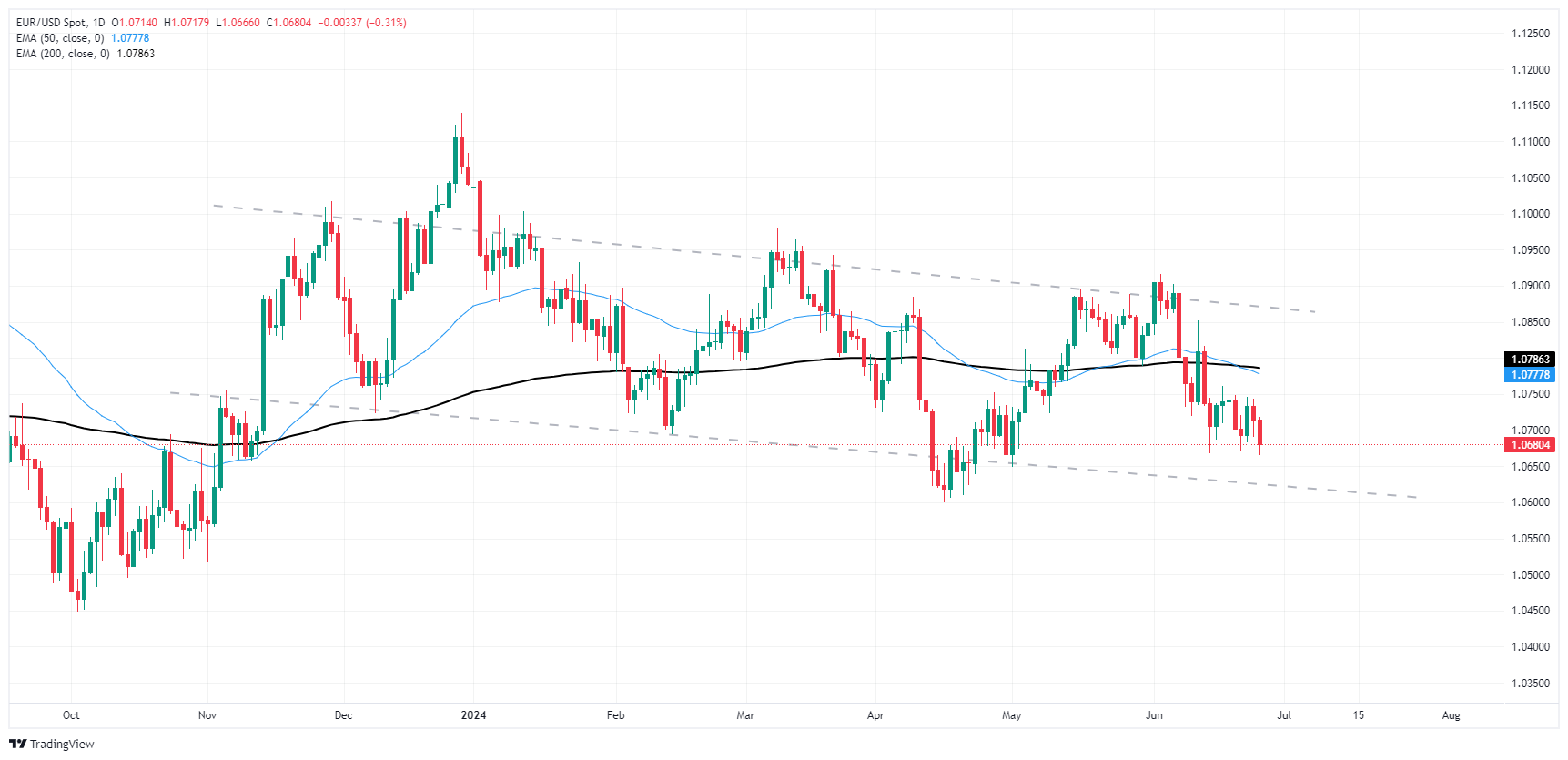- EUR/USD flubs the 1.0700 handle as bearish flows keep the Fiber pinned.
- Broad-market sentiment favored the Greenback on Wednesday as rate cut hopes dry up.
- Late-week key data prints to drive market momentum after an easy start to the week.
EUR/USD backslid into the 1.0680 region on Wednesday after the German GfK Consumer Confidence Survey for July ticked lower unexpectedly, and a lack of meaningful data during the American trading session left investors to chew on a cautious Federal Reserve (Fed) stance this week that saw rate cut bets shift lower.
Forex Today: Investors look at US PCE and French elections
German consumer confidence backslid to -21.8 for July, missing the forecast recovery to -18.9 from the previous month’s revised -21.0. Despite a slow and steady recovery in the German GfK Consumer Confidence Survey, Wednesday’s downside print kicked the legs out from beneath the already-battered Euro.
US New Home Sales Change in May clocked in a -11.3% decline MoM on Wednesday, compared to the previous month’s 2.0%, revised sharply from the initial print of -4.7%.
Confidence survey releases continue through Thursday, with pan-EU Business Climate, Consumer Confidence, and Economic Sentiment Indicator data points all slated for release during the European market window. US Durable Goods Orders, revisions to first-quarter Gross Domestic Product (GDP), and weekly Initial Jobless Claims will follow during Thursday’s American trading session.
US QoQ GDP is expected to tick upward slightly to 1.4% from the initial print of 1.3%, while May’s US Durable Goods Orders are expected to print a -0.1% contraction compared to the previous month’s revised 0.6%. US Initial Jobless Claims for the week ended June 21 are expected to tick slightly lower to 236K from the previous 238K, but the figure is expected to come in above the four-week average of 232.75K.
US Core PCE Price Index inflation is expected to tick down YoY to 2.6% from the previous 2.8% as market participants hope for further signs of easing inflation to help push the Federal Reserve (Fed) towards rate cuts sooner rather than later.
The market's confidence in a rate cut from the Federal Open Market Committee (FOMC) on September 18 has decreased. The probability of at least a quarter-point rate cut has decreased to around 60%, down from a peak of just above 70% last week, according to the CME’s FedWatch Tool.
Euro PRICE This week
The table below shows the percentage change of Euro (EUR) against listed major currencies this week. Euro was the strongest against the New Zealand Dollar.
| USD | EUR | GBP | JPY | CAD | AUD | NZD | CHF | |
|---|---|---|---|---|---|---|---|---|
| USD | 0.13% | 0.19% | 0.53% | 0.11% | -0.05% | 0.64% | 0.36% | |
| EUR | -0.13% | 0.07% | 0.48% | 0.05% | -0.15% | 0.55% | 0.30% | |
| GBP | -0.19% | -0.07% | 0.34% | -0.05% | -0.23% | 0.48% | 0.23% | |
| JPY | -0.53% | -0.48% | -0.34% | -0.43% | -0.54% | 0.16% | -0.17% | |
| CAD | -0.11% | -0.05% | 0.05% | 0.43% | -0.14% | 0.53% | 0.28% | |
| AUD | 0.05% | 0.15% | 0.23% | 0.54% | 0.14% | 0.71% | 0.46% | |
| NZD | -0.64% | -0.55% | -0.48% | -0.16% | -0.53% | -0.71% | -0.26% | |
| CHF | -0.36% | -0.30% | -0.23% | 0.17% | -0.28% | -0.46% | 0.26% |
The heat map shows percentage changes of major currencies against each other. The base currency is picked from the left column, while the quote currency is picked from the top row. For example, if you pick the Euro from the left column and move along the horizontal line to the US Dollar, the percentage change displayed in the box will represent EUR (base)/USD (quote).
EUR/USD technical outlook
Intraday action continues to get squeezed between the 200-hour Exponential Moving Average (EMA) at 1.0722 and a supply zone baked in below 1.0680. The Fiber is poised for a fresh decline into new near-term lows below 1.0660 if buyers aren’t able to shake off a pattern of descending highs.
A rough descending channel is keeping daily candlesticks tilted towards the downside, and price action continues to waffle on the south side of the 200-day EMA at 1.0796. A last bearish push to 1.0600 could see a bullish bounce back towards chart territory north of 1.0700, while a continuation will see EUR/USD chalk in fresh lows for 2024.
EUR/USD hourly chart
EUR/USD daily chart
Euro FAQs
The Euro is the currency for the 20 European Union countries that belong to the Eurozone. It is the second most heavily traded currency in the world behind the US Dollar. In 2022, it accounted for 31% of all foreign exchange transactions, with an average daily turnover of over $2.2 trillion a day. EUR/USD is the most heavily traded currency pair in the world, accounting for an estimated 30% off all transactions, followed by EUR/JPY (4%), EUR/GBP (3%) and EUR/AUD (2%).
The European Central Bank (ECB) in Frankfurt, Germany, is the reserve bank for the Eurozone. The ECB sets interest rates and manages monetary policy. The ECB’s primary mandate is to maintain price stability, which means either controlling inflation or stimulating growth. Its primary tool is the raising or lowering of interest rates. Relatively high interest rates – or the expectation of higher rates – will usually benefit the Euro and vice versa. The ECB Governing Council makes monetary policy decisions at meetings held eight times a year. Decisions are made by heads of the Eurozone national banks and six permanent members, including the President of the ECB, Christine Lagarde.
Eurozone inflation data, measured by the Harmonized Index of Consumer Prices (HICP), is an important econometric for the Euro. If inflation rises more than expected, especially if above the ECB’s 2% target, it obliges the ECB to raise interest rates to bring it back under control. Relatively high interest rates compared to its counterparts will usually benefit the Euro, as it makes the region more attractive as a place for global investors to park their money.
Data releases gauge the health of the economy and can impact on the Euro. Indicators such as GDP, Manufacturing and Services PMIs, employment, and consumer sentiment surveys can all influence the direction of the single currency. A strong economy is good for the Euro. Not only does it attract more foreign investment but it may encourage the ECB to put up interest rates, which will directly strengthen the Euro. Otherwise, if economic data is weak, the Euro is likely to fall. Economic data for the four largest economies in the euro area (Germany, France, Italy and Spain) are especially significant, as they account for 75% of the Eurozone’s economy.
Another significant data release for the Euro is the Trade Balance. This indicator measures the difference between what a country earns from its exports and what it spends on imports over a given period. If a country produces highly sought after exports then its currency will gain in value purely from the extra demand created from foreign buyers seeking to purchase these goods. Therefore, a positive net Trade Balance strengthens a currency and vice versa for a negative balance.
Information on these pages contains forward-looking statements that involve risks and uncertainties. Markets and instruments profiled on this page are for informational purposes only and should not in any way come across as a recommendation to buy or sell in these assets. You should do your own thorough research before making any investment decisions. FXStreet does not in any way guarantee that this information is free from mistakes, errors, or material misstatements. It also does not guarantee that this information is of a timely nature. Investing in Open Markets involves a great deal of risk, including the loss of all or a portion of your investment, as well as emotional distress. All risks, losses and costs associated with investing, including total loss of principal, are your responsibility. The views and opinions expressed in this article are those of the authors and do not necessarily reflect the official policy or position of FXStreet nor its advertisers. The author will not be held responsible for information that is found at the end of links posted on this page.
If not otherwise explicitly mentioned in the body of the article, at the time of writing, the author has no position in any stock mentioned in this article and no business relationship with any company mentioned. The author has not received compensation for writing this article, other than from FXStreet.
FXStreet and the author do not provide personalized recommendations. The author makes no representations as to the accuracy, completeness, or suitability of this information. FXStreet and the author will not be liable for any errors, omissions or any losses, injuries or damages arising from this information and its display or use. Errors and omissions excepted.
The author and FXStreet are not registered investment advisors and nothing in this article is intended to be investment advice.
Recommended content
Editors’ Picks

Australian Dollar steady as markets asses minor US data
The AUD/USD regained positive traction on Thursday following the overnight pullback from a one-week top. A softer US Dollar and a positive risk tone benefited the Aussie, as well as the Reserve Bank of Australia’s (RBA) hawkish stance.

EUR/USD: Further losses now look at 1.0450
Further strength in the US Dollar kept the price action in the risk-associated assets depressed, sending EUR/USD back to the 1.0460 region for the first time since early October 2023 prior to key releases in the real economy.

Gold faces extra upside near term
Gold extends its bullish momentum further above $2,660 on Thursday. XAU/USD rises for the fourth straight day, sponsored by geopolitical risks stemming from the worsening Russia-Ukraine war. Markets await comments from Fed policymakers.

Ethereum Price Forecast: ETH open interest surge to all-time high after recent price rally
Ethereum (ETH) is trading near $3,350, experiencing an 10% increase on Thursday. This price surge is attributed to strong bullish sentiment among derivatives traders, driving its open interest above $20 billion for the first time.

A new horizon: The economic outlook in a new leadership and policy era
The economic aftershocks of the COVID pandemic, which have dominated the economic landscape over the past few years, are steadily dissipating. These pandemic-induced economic effects are set to be largely supplanted by economic policy changes that are on the horizon in the United States.

Best Forex Brokers with Low Spreads
VERIFIED Low spreads are crucial for reducing trading costs. Explore top Forex brokers offering competitive spreads and high leverage. Compare options for EUR/USD, GBP/USD, USD/JPY, and Gold.